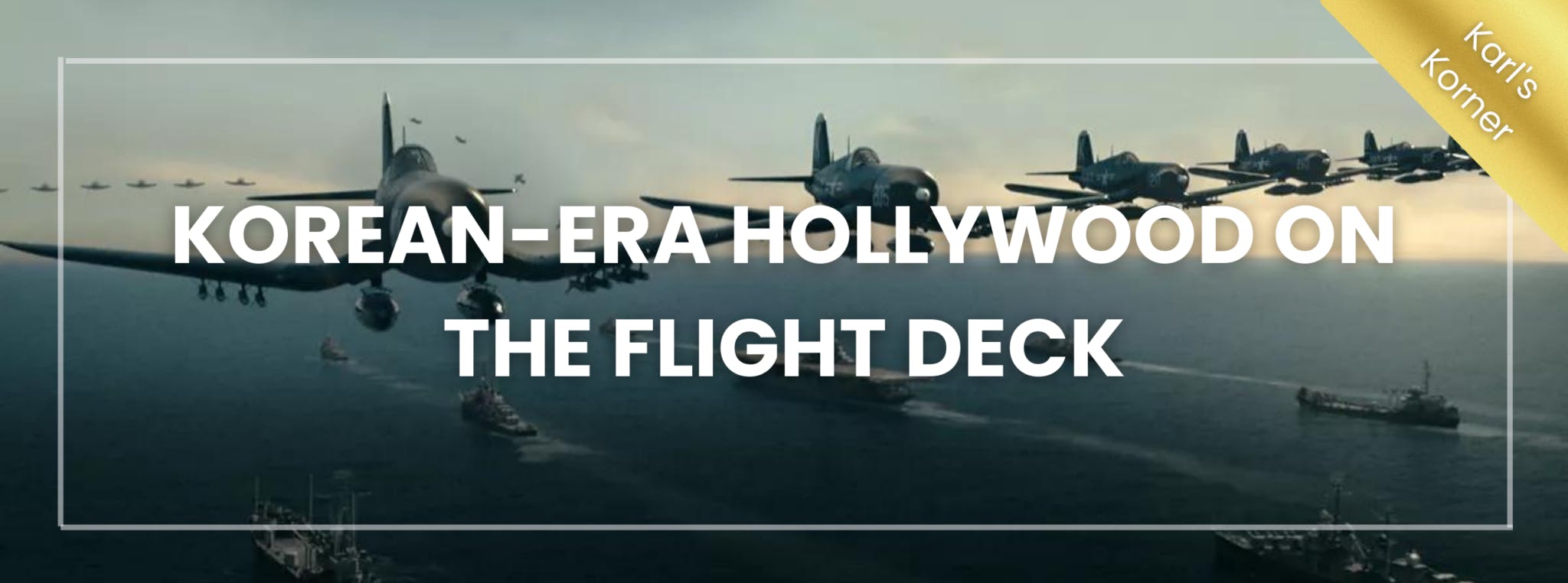 July 21, 2023 | Karl’s Korner
July 21, 2023 | Karl’s KornerKorean-Era Hollywood on the Flight Deck
The Hollywood Take on the Korean War
USS Midway Museum commemorated the 70th anniversary of the Korea War Armistice on July 21 with a showing of the recently-released motion picture “Devotion,” based upon the real-life story of the Navy’s first African-American naval aviator Jesse Brown and the actions of his squadron mate Tom Hudner to save Brown’s life. Korean War films became a cottage industry in 1950s Hollywood, though the ambiguity of the war (when compared to World War II) and its less-than-definitive conclusion challenged screenwriters. The emergence of a new conflict with its own drama in Southeast Asia dominated the attention of filmmakers from the 1960s to well into the 1990s. The iconoclastic “M*A*S*H” was the only notable Hollywood movie set entirely within the Korean War since the early 1960s.
Carrier Aviation in Focus: From Fiction to Reality
Aviation films have always been a good bet for filmmakers, and carrier aviation was no stranger to Hollywood. With naval aviation well established in nearby San Diego, acquiring naval cooperation in filming was usually easy. Carrier-based films like Hell Divers, Flight Command, and Dive Bomber presented flight deck aviation in a stylized manner even before World War II. The Korean War from the tailhook perspective is likewise memorialized by a trio of 1950s films that run the gamut from magnificent to utterly forgettable. Two are based extensively on the writings of novelist James Michener who served as a war correspondent with the fleet during the Korean War.
Michener’s Impact: From Fact-Based to Fictionalized Tales
The first film from his pen was “Men of the Fighting Lady” in 1954. A standard actioner, the film’s plot relies on the recollections of a flight surgeon, played by Walter Pigeon, who relates to Michener (portrayed by Louis Calhern), the story of a young pilot coming up through the squadron and tough missions against targets ashore in Korea.
The yarn-spinning culminates in a fact-based incident where the pilot was blinded by enemy fire and was talked down to a safe landing by a fellow flier. Less credibly, in the film version, this resulted in an arrested landing back on the carrier instead of at a shore airfield from the actual incident.
A credit to the production was the original photography on the carrier USS Oriskany (CV-34) depicting shipboard life and flight deck operations off San Diego in 1953. For the combat scenes, though, stock footage was employed.
The other Michener tale (though without the writer’s character portrayal) appeared onscreen shortly afterward was “The Bridges at Toko-Ri,” arguably the best depiction of carrier aviation to date. The film follows the dilemma of a reluctant reservist, portrayed by William Holden, who left his law practice to return to carrier aviation. The story’s climax leads to a harrowing attack on heavily defended railway bridges and a surprising downing of the film’s hero by fragments of his bombs at an easy secondary target. A desperate rescue attempt results in the shoot down of a helicopter crewed by Mickey Rooney and Earl Holliman, Jr. Before a second rescue could mount, the enemy closes in on the men and finishes them after a bloody standoff. Both films benefited from extensive photography aboard the Oriskany, including lavish coverage of flight deck operations in the last years of straight deck carriers. In addition to the unfortunate ending for a Hollywood picture of that era (reportedly shot that way at actor Holden’s insistence), the film is one of the few flying pictures with a diverting ground sequence featuring the antics of Rooney’s and Holliman’s characters on liberty in Tokyo.
Triumphs and Missteps: Reflecting on Korean-Era Aviation Films
Unfortunately, the final film in this trifecta reflects an indifferent approach to the subject matter. The original script for “Air Strike” from 1955 purportedly had ambitions about a pair of pilots overcoming ethnic bigotry among their shipmates. Still, the Navy expressed hostility to such a depiction of the fleet, and those elements were removed from the plot. The result was a chaotic mess of indifferent dialog and a laughable splicing of stock aerial footage from World War II and the early jet era without regard for continuity. In fact, the editing creates an impression that the fighter squadron depicted flew at least five different jet fighters (the F9F Panther and Cougar, the FH Phantom-1, and the FJ-1 and FJ-3 Fury), often in the same flying sequence!
This inconsistency carried over to depictions of different carriers, though USS Essex (CV-9) was the primary subject. Worse, the action was said to be in the Atlantic as the new squadron was working up for eventual action in Korea.
Although the Korean War was a difficult subject on the big screen, having four separate dramas on carrier aviation for the viewer is a surprising trove for such a specialist topic. “Devotion” is a welcome addition to this modest pantheon of flying pictures. Hopefully, more stories from this crucial period of carrier aviation will be brought to the public.
Launch em’… until next time,
Karl
Your Adventure Starts Now
Your email is the key to information that will open up all your possibilities for exploring the mighty Midway!

